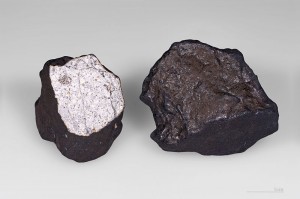Meteorites and Magnetism
Did you catch the Perseid meteor shower last night? If you did, then you know firsthand just how magical it can be to watch these tiny bits of space soar into the atmosphere. The Perseid meteor shower is one of the biggest celestial events of the year. Occurring annually, the shower is a result of the Earth passing through the debris of the comet Swift-Tuttle.
Most meteors are disintegrated by the gases in the atmosphere and never make it to the surface. Once in a blue moon, a meteor lands on the ground, and then we have a meteorite.
 Photo by Didier Descouens[/caption]
You should first examine the possible meteorite and where you discovered it before testing it with a magnet. Often, volcanic earth rocks are mistaken for fallen meteors. If your discovery looks like much of the terrain around it, is filled with sponge-like holes and is very light, it may not be a meteorite.
However, a meteorite’s attributes may differ based on its type, so it is important to know the various types and how they react to rare earth magnets.
There are three different types of meteorites. They are:
Photo by Didier Descouens[/caption]
You should first examine the possible meteorite and where you discovered it before testing it with a magnet. Often, volcanic earth rocks are mistaken for fallen meteors. If your discovery looks like much of the terrain around it, is filled with sponge-like holes and is very light, it may not be a meteorite.
However, a meteorite’s attributes may differ based on its type, so it is important to know the various types and how they react to rare earth magnets.
There are three different types of meteorites. They are:
What is a Meteorite?
When a meteor manages to make it past the atmosphere without disintegrating and impacts with the Earth’s surface, then it is called a meteorite. Even though they fly into our planet from outer space, they consist of some of the same metals that we have here. For instance, extraterrestrial iron is found in most meteorites. Since meteorites have iron in them, magnets are attracted to them and can be used as a preliminary meteorite test.How to Detect Meteorites with Magnets
[caption id="attachment_940" align="alignnone" width="300"] Photo by Didier Descouens[/caption]
You should first examine the possible meteorite and where you discovered it before testing it with a magnet. Often, volcanic earth rocks are mistaken for fallen meteors. If your discovery looks like much of the terrain around it, is filled with sponge-like holes and is very light, it may not be a meteorite.
However, a meteorite’s attributes may differ based on its type, so it is important to know the various types and how they react to rare earth magnets.
There are three different types of meteorites. They are:
Photo by Didier Descouens[/caption]
You should first examine the possible meteorite and where you discovered it before testing it with a magnet. Often, volcanic earth rocks are mistaken for fallen meteors. If your discovery looks like much of the terrain around it, is filled with sponge-like holes and is very light, it may not be a meteorite.
However, a meteorite’s attributes may differ based on its type, so it is important to know the various types and how they react to rare earth magnets.
There are three different types of meteorites. They are:
- Iron meteorites: have a high content of iron and therefore, a powerful magnetic attraction.
- Stony-irons: have a lower iron content than iron but will still stick to high powered magnets.
- Stone: have a very minimal metal or iron content but may still be attracted to strong neodymium magnets.
- Take your suspected extraterrestrial rock and place it on a non-magnetic surface.
- Hover your strong magnet close to the rock and see if it is attracted. You can also place it on the rock and see how much it sticks.
- If the magnet and possible space rock are not attracted to one another, then you probably don’t have a meteorite.
- If the two do attract, you may.

